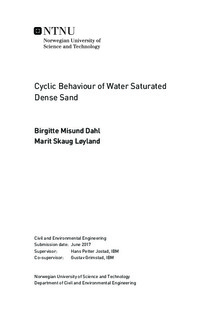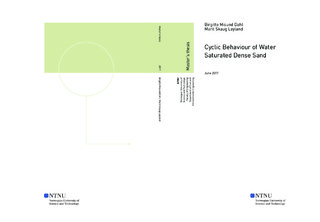| dc.description.abstract | Several monotonic and cyclic triaxial tests have been performed at NGI in association with the ongoing strategic project, SP9. The test material is dense saturated sand from the Siri offshore field in the North Sea, and this study includes interpretations of the tests within an elasto-plastic constitutive framework. Different drainage conditions have been evaluated, and characteristic behaviours have been established.
There have been observed deviation in the pore water pressure generation in the different cyclic triaxial tests. Sample preparation method affects the properties of the sand, and is most likely the reason for the deviations. Cycles from different tests with the same initial mean stress have been compared, and there is a striking resemblance of the response. This indicates that the material considers the mean stress condition as a state parameter, and is independent on how it got to the specific stress condition.
A monotonic and cyclic simulation of the SANISAND model limited to the triaxial stress space have been implemented in Excel. A verification of the model and a parameter study have been carried out. The response simulated by SANISAND has been compared with results from the triaxial tests performed on Siri sand. The SANISAND input parameters have been fitted to the monotonic tests, and then developed further for the cyclic simulations. This is done by evaluating the different SANISAND formulations and how the different parameters affect the simulations. One set of parameters has been applied in all cyclic simulations of the Siri sand. However, it has been observed in the results that due to some variation in stress condition and relative density of the tests, small modifications of the parameters are required to represent the behaviour of each test in an optimal manner.
This study indicates that the SANISAND model has some limitations. The representations of incremental plastic and volume strains are somewhat inaccurate, which result in inaccurate simulations of total shear and volume strains.
Despite the limitations, the model represents the behaviour of water saturated dense sand in an adequate manner. The model is relatively simple compared to the alternatives, and the user-friendly framework is advantageous. | |

